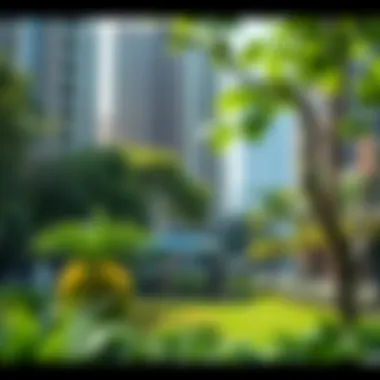The Importance of Public Parks in Urban Environments


Intro
Public parks have evolved over time from mere patches of greenery amid the concrete jungle to vital lifelines within the urban landscape. In cities where high-rises dominate the skyline, these parks serve myriad purposes, acting as shelters of solace, social hubs, and effective green buffers. Their significance extends far beyond aesthetic appeal; they play an essential role in enhancing environmental sustainability as well as nurturing community ties. This article delves into the intricate fabric of public parks, particularly in dynamic urban settings like Dubai, shedding light on their impact and challenges faced in planning and maintenance.
Area Overview
Neighborhood Characteristics
The charm of public parks often resides in their surroundings. Neighborhoods imbued with parks are frequently characterized by an unmistakable vibrancy. In areas like Dubai, public parks cater to a diverse population, including expatriates and locals alike. You will find families enjoying picnics, joggers dusting off the morning dew, and children playing on well-crafted playgrounds.
Such spaces not only provide a breath of fresh air but also add to the communal life. Parks like Al Barsha Park and Zabeel Park symbolize tranquillity, often breaking the monotony of urban living. Their strategic placement can influence housing prices, making properties adjacent to parks more appealing to potential buyers. The allure of having a green space nearby can outweigh the high cost of living in bustling priets such as Downtown Dubai or Dubai Marina.
Cost of Living Analysis
When examining the cost of living in urban settings, the presence of well-maintained public parks often offers residents significant value. Access to these green spaces is not merely about having a pretty view; it's about quality of life. Families may choose to forgo larger living spaces in favor of neighborhoods rich in parks, seeing it as an investment in wellness and leisure.
While it might appear that housing in park-centric areas comes with a higher price tag, the benefits can sometimes offset these costs. Parks can reduce stress levels, promote physical health, and foster social interactions, ultimately contributing to a city's overall desirability. The financial outlay of maintaining these areas falls under the local government's purview, highlighting a crucial aspect of urban planning.
Lifestyle Insights
Cultural and Recreational Activities
Public parks present an ideal backdrop for various cultural and recreational activities. They often host events such as open-air concerts, food festivals, and art exhibitions. In Dubai, it is not uncommon to find roving performers engaging with visitors, adding to the festive atmosphere. Parks can bring a sense of community, tying together people from various walks of life, fostering friendships, and creating shared experiences.
Additionally, opportunities for outdoor exercise abound. From yoga classes held in shady corners to organized sports leagues attracting passionate players, the parks are a catalyst for healthy living.
Local Dining Experiences
Public parks often act as a magnet for nearby dining establishments. With their open atmosphere, picnic areas lure food trucks, cafes, and restaurants into setting up shop close by. In Dubai's vibrant food scene, new culinary delights can often be found at park-associated dining options, enabling residents and visitors to experience the city’s thriving gastronomy while surrounded by nature.
Dining al fresco in a park not only enhances the experience but also encourages a laid-back lifestyle amidst the hustle and bustle of city life. This unique intersection of dining and leisure contributes to a richer urban experience, emphasizing the role of parks in enhancing overall well-being.
"Public parks do more than just beautify urban areas; they enhance city life by encouraging connections between people and fostering community spirit."
Engaging with public parks offers a glimpse into the broader rhythms of urban life, highlighting how these spaces play a pivotal role in building social networks and nurturing the environment.
As we look ahead, the continuing evolution and integration of public parks into urban planning reveal a fundamental truth: these green spaces are not merely an accessory but an integral part of the urban tapestry, woven tightly with the threads of culture, leisure, and communal harmony.
The Importance of Public Parks
Public parks form the backbone of urban landscapes, providing spaces for recreation, relaxation, and environmental sustenance. These green patches in concrete jungles play a plethora of roles that go far beyond aesthetic appeal. They are vital for enhancing the quality of urban life, particularly in dense cities where personal space is at a premium. Parks offer a reprieve from the hustle and bustle, effectively bridging the gap between nature and urban living.
Health Benefits
Physical activity
Physical activity is one of the standout advantages offered by public parks. When people step into a park, they're not just entering a green space; they're stepping into opportunities for exercise. Whether it's walking, jogging, biking, or playing sports, parks encourage a more active lifestyle. This helps combat the rising issues of obesity and related health conditions prevalent in urban areas.
The freedom to engage in various activities underpins the role of parks in promoting health. The open spaces provide enough room for family gatherings and friendly matches, creating an environment where fitness meets fun. This approach to exercise is crucial, as it dovetails physical health with both recreational and social aspects of life, making it a very appealing choice for various demographics.
Mental well-being
Public parks do wonders for mental well-being too. Nature has this inherent capacity to calm the mind and alleviate stress. Studies have shown that even a short stroll in a park can uplift mood and foster a sense of calm. Greenery, fresh air, and the sounds of chirping birds can be like a balm for weary souls struggling in high-pressure urban settings.
The unique feature of parks in this context is their accessibility. They are generally open to all, providing a refuge from daily stresses. However, it’s not just about finding solitude; socializing in parks also contributes positively to mental health. Meeting friends or family in these spaces can enhance community ties and foster deeper emotional connections.
Environmental Impact


Urban biodiversity
Urban biodiversity is another vital aspect underscored by public parks. These spaces are often home to a myriad of flora and fauna, providing crucial habitats within cities. Parks contribute significantly to the ecological balance, supporting both local wildlife and plant life, while also offering a natural environment where citizens can reconnect with nature.
The benefit here lies in the variety of species that parks support, promoting a healthy ecosystem right in the heart of urban landscapes. However, the unique offset is that not every park is designed to encourage biodiversity effectively. Some lack native plants or sufficient space for wildlife, which can lead to diminished ecological benefits.
Climate regulation
Public parks play a pivotal role in climate regulation. They act like sponges, absorbing rainwater and minimizing urban heat effects through tree canopy cover. By cooling the air, parks help reduce reliance on air conditioning in nearby buildings and improve overall air quality.
The significance of this feature cannot be overstated—especially in sprawling urban settings experiencing rapid development. However, a challenge commonly faced is the maintenance of green spaces that effectively regulate climate; poorly designed parks may not maximize this benefit and can become littered with non-native plants that don’t support local ecosystems.
Social Gatherings
Community events
Community events in parks provide an ideal setting for fostering bonds among residents. From farmers’ markets to outdoor concerts, these gatherings draw diverse crowds. They create opportunities for residents to engage, learn, and share experiences, essentially stitching together the fabric of community life.
These events highlight the beautiful potential parks have to unite different ethnic and age groups in a shared love for outdoor activities. However, planning such events can be tricky; mismanagement may lead to overcrowding or dissatisfaction among park-goers needing a peaceful retreat.
Social interactions
Parks are also hubs for social interactions. They serve as venues for casual meet-ups, informal sports gatherings, or simple day outings with family. The accessibility of parks encourages casual conversations among strangers, fostering a sense of community.
This trait emerges as a double-edged sword, as not all parks offer sufficient amenities or safe environments. Areas lacking facilities can restrict the type of interactions that take place, affecting the quality of social experiences. The challenge here is ensuring safe and welcoming spaces for all, enhancing the community's opportunity to bond through shared experiences.
Public Parks in Dubai
Public parks in Dubai hold a pivotal role in shaping the urban landscape and lifestyle of its inhabitants. Amid the towering skyscrapers and bustling thoroughfares, these green sanctuaries provide much-needed relief and recreation for residents and tourists alike. The significance of these parks extends beyond mere aesthetics; they serve as essential hubs for community interaction, recreation, and environmental benefit. Understanding the dynamics of public parks in Dubai reveals their multifaceted contributions to urban life.
Historical Context
Evolving park spaces
As Dubai underwent rapid urbanization, the concept of park spaces evolved dramatically. Initially, parks were sparse and often limited in design and function. However, today’s parks are thoughtfully curated to incorporate elements that cater to a diverse population. The key characteristic of evolving park spaces in Dubai is their increasing sophistication and multifunctionality. In response to the city's growth and demographic changes, these parks now offer spaces for leisure, fitness, and relaxation.
A unique feature of these evolving park spaces is the harmonious blend of natural and artificial elements. Take Al Safa Park, for instance, where manicured gardens coexist with well-planned recreational facilities. One advantage of this evolution is that parks can cater to a broad range of visitors, from families with young children to fitness enthusiasts seeking jogging trails.
Influences of urban growth
Dubai’s continuous urban expansion has formidable implications for public parks. As neighborhoods sprout and residential areas burgeon, the demand for accessible green spaces has surged. The characteristic feature of this influence is the integration of parks into new urban developments, which help maintain a semblance of greenery amidst concrete jungles. Such integration proves to be beneficial, as these spaces contribute not only to the aesthetic appeal but also to the overall quality of life.
A unique angle to consider here is the planning phase which can sometimes overshadow the necessity of these green spaces. While new developments often prioritize commercial and residential space, the backlash from communities has resulted in advocating for sustainable park spaces in every new project. This can lead to a balancing act where parks are sometimes viewed as mere afterthoughts rather than integral parts of urban planning.
Current Park Features
Design and aesthetics
The design and aesthetics of Dubai’s public parks are not purely functional; they also aim to capture the essence of the region's culture and heritage. Beautifully landscaped gardens not only enhance the visual appeal but also provide an atmosphere conducive to relaxation and enjoyment. The key characteristic of park design in Dubai is the incorporation of local flora and eco-friendly materials, reflecting a commitment to sustainability.
A distinctive element of this design approach is the use of innovative landscaping techniques that cater to the desert environment. For instance, parks often feature shaded areas and water elements that mitigate the harsh sun, providing visitors with comfort and a respite from the heat. This blending of aesthetics with functionality makes the parks not only attractive but also practical for year-round use.
Type of facilities
Facilities in Dubai's public parks play a crucial role in enhancing user experience. They range from basic amenities like benches and restrooms to more elaborate setups including playgrounds, sports courts, and picnic areas. The hallmark of these facilities is their inclusivity, catering to a varied demographic. For example, Al Safa Park includes jogging paths, cycling tracks, and children's playgrounds, which invites families and fitness aficionados alike.
The introduction of smart facilities in some parks can be seen as a forward-thinking approach to urban parks. These may include free Wi-Fi zones, interactive information panels, and online booking systems for event spaces. However, with the introduction of technology, there can be a downside, as dependence on these features may detract from the natural elements which many visitors cherish.
Notable Public Parks


Al Safa Park
Al Safa Park stands out not only for its size but also for its versatile offerings. Located near the Dubai Water Canal, this park is home to walking trails, picnic spots, and children's play areas. The significant aspect of Al Safa Park is its ability to attract diverse groups of people at various times of the day, thus fostering a sense of community. It also serves as a venue for local events, which enhances social interaction among the residents.
One unique feature of this park is its central location, making it accessible from different corners of the city. This accessibility is both an advantage and a disadvantage; while it attracts large crowds, it can also lead to congestion during peak times, thus straining resources and maintenance efforts.
Zabeel Park
Not far behind in popularity is Zabeel Park, designed with an emphasis on both leisure and recreation. The park is noteworthy for its vast green spaces, dedicated jogging tracks, and even a large lake. One of the defining characteristics of Zabeel Park is its educational aspect, featuring the Dubai Frame which provides insights into local history and future aspirations.
What sets Zabeel Park apart is its roller skating rink, which attracts younger visitors and allows them to engage in activities beyond the typical park experience. Still, the balance between providing fun and maintaining tranquility can sometimes present challenges, especially as the park often hosts various events leading to larger crowds.
Dubai Creek Park
Dubai Creek Park is often considered a crown jewel among the city's parks due to its picturesque views and rich offerings. This park has a botanical garden, and an amphitheater, and provides bike rentals, catering to a wide range of visitors. The essential aspect of Dubai Creek Park is its scenic beauty which encourages relaxation and leisure amidst nature.
Its unique feature lies in the proximity to the historic Dubai Creek, allowing guests to immerse themselves in both natural and cultural experiences. However, its popularity can sometimes be detrimental; heavy foot traffic can lead to wear and tear, necessitating regular maintenance and upgrades to ensure a lasting appeal.
For more information and a deeper understanding of the parks in Dubai, visit Wikipedia.
Community Engagement in Park Design
Public parks serve as essential green spaces within urban environments, but their utility is greatly enhanced when community engagement takes center stage during the design process. Involving residents in the planning and development of these parks leads not only to spaces that cater to their specific needs but also fosters a sense of ownership and responsibility among community members. Engagement with the community can transform a neglected plot of land into a vibrant and bustling area where people gather, exercise, and enjoy nature.
Participatory Planning
Stakeholder involvement
When considering park design, stakeholder involvement cannot be overlooked. This aspect invites various community members—including local residents, business owners, and city officials—to participate in discussions about what they want to see in a park. It’s like cooking a new recipe; the more people contribute their favorite spices, the better the dish comes out. This collaborative process strengthens community ties. Not only does it improve park relevance, but it also enhances the stakeholder's commitment to the park’s longevity. However, getting everyone on the same page can present its own set of challenges, as differing opinions may clash, delaying the process.
Feedback mechanisms
Next up is feedback mechanisms. These serve as structured channels for community members to express their thoughts on park proposals. Whether through surveys, public meetings, or online platforms, these channels allow residents to share their ideas and concerns, ensuring the design aligns with their expectations. Such mechanisms provide a unique feature; they create an iterative design process where changes can be made based on community input. One drawback to consider is that these feedback systems can sometimes lead to significant delays if consensus is not reached. But the ultimate benefit of shaping a public space that reflects the community’s desires outweighs those hurdles.
Addressing Diverse Needs
Public parks must cater to a wide variety of community members. Thus, addressing diverse needs is vital in their design. All people, regardless of age or ability, should find value in these greenspaces.
Accessibility
Accessibility means more than just having wheelchair ramps installed. It encompasses the entire experience of visiting the park. This includes the layout of pathways, visibility of signage, and even the availability of facilities like restrooms and seating. The key characteristic here is inclusivity—parks should invite people from all walks of life. A well-designed park makes it easy for everyone to enjoy its benefits, securing it an essential spot in urban planning. However, while making parks accessible can sometimes demand additional funding and planning, the long-term advantage is immense: a happier, more engaged community.
Age-specific facilities
Lastly, consider age-specific facilities. Kids, teenagers, adults, and seniors all have differing needs and preferences. Parks designed with a variety of age-appropriate elements—from playgrounds for children to tranquil walking paths for seniors—will see greater engagement across the board. This aspect of park design can be its own unique feature; multi-generational playgrounds, for instance, can encourage families to spend time together while having fun. However, there might be limitations in space and budget, which could hinder the full incorporation of these special facilities. Yet, urban parks that meet the needs of all ages not only increase foot traffic but also foster community bonding.
A thoughtful approach to community engagement in park design can transform these natural spaces into essential hubs for all. From participatory planning to considering diversified needs, every choice impacts how public parks benefit the urban landscape. When the voices of the community dictate design decisions, the end result is parks that serve the people they were meant for, making them even more valuable.
Challenges Facing Public Parks
Public parks play a crucial role in enhancing urban life, but they are not without their complications. Understanding the challenges these essential spaces face is vital in ensuring their sustainability and effectiveness. The pressures exerted by urban development and ongoing maintenance issues can seriously hinder the role public parks play within communities.
Urban Development Pressures
Land use conflicts
When cities expand, the need for more housing and commercial spaces often results in land use conflicts. Parks, which stand as islands of green in urban landscapes, can become prime targets for development. This often pits developers against community members who value these parks as necessary breathing spaces.


A key characteristic of land use conflicts is that they can lead to significant community tension. On one hand, there’s an undeniable demand for housing, especially in populous cities. On the other hand, converting parkland into commercial or residential properties can diminish the quality of life for residents who rely on these parks for relaxation and recreation. The balance here is delicate, making it a critical consideration in any discussion about urban spaces.
The unique feature of land use conflicts reveals both challenges and potentials. On one side, when public parks are shrunk or repurposed, people may find themselves with fewer areas for outdoor activities, directly affecting their health and social interactions. Conversely, striking a balance between development and preservation can lead to innovative urban planning, creating multifunctional spaces that meet various needs—be it photography, picnics, or play.
Commercialization
Commercialization introduces another layer of complexity in the management of public parks. This involves transforming park spaces into revenue-generating sites, which might include adding cafes, kiosks, or event spaces. While this can lead to increased funding for park maintenance, it can also undermine the tranquility and accessibility that parks typically offer.
Highlighting the key characteristic of commercialization, it is often seen as a popular option due to its potential to financially sustain park resources. Parks that are equipped with amenities can attract more visitors, which in turn may boost revenue through rentals or concessions. However, this approach can also draw criticism if visitors feel that park experiences are being commodified or if they perceive the parks as more of a commercial enterprise than a community space.
The unique feature of commercialization lies in its dual nature—it aids in resource generation but can detract from the park's original purpose as a communal sanctuary. In this article, we explore whether such ventures strengthen or weaken the bonds that parks are supposed to nurture among local residents.
Maintenance Issues
As parks age, maintenance issues become increasingly apparent. Understanding how these challenges affect the quality and availability of public parks is vital for future urban planning. Maintenance concerns include resource allocation and dealing with physical deterioration.
Resource allocation
The effective distribution of resources is paramount when it comes to park maintenance. Many parks suffer from insufficient funding, which can result in neglected landscaping, broken facilities, and insufficient cleanup efforts. Resource allocation must balance the needs of various neighborhoods and ensure equitable support across the city.
A key characteristic of resource allocation in this context is its link to community satisfaction. When parks are well-maintained, residents are more likely to utilize them, fostering community engagement and promoting public health. Inadequate resources, however, can lead to locations becoming rundown and unwelcoming, decreasing their usability and perceived value.
The unique feature related to resource allocation serves to emphasize the need for sustainable budgeting practices within municipalities. Strategies such as community support initiatives or volunteer programs can supplement funding and improve maintenance outcomes. Fostering community involvement can enhance pride in these green spaces, counteracting deficiencies in official resources.
Physical deterioration
Physical deterioration is another pressing issue that plagues public parks. Over time, wear and tear can lead to broken benches, unruly weeds, and degraded walking paths, all of which can deter visitors and diminish the park’s value. This become especially relevant as cities experience changes in climate and higher foot traffic.
One key characteristic of physical deterioration is that it often goes unnoticed until it becomes a significant issue. While a cracked pavement may seem minor, it can indicate deeper systemic problems within the park’s maintenance regime. The urgency of addressing these conditions cannot be understated; failing to act may cause long-term damage to not only the physical characteristics of the park but also to the community sentiment.
The unique aspect of physical deterioration raises critical questions about urban management's ability to adapt and prevent decline. Implementing proactive maintenance protocols can keep parks more appealing, ensuring that they remain vital parts of urban life. By drawing attention to these challenges, this article strives to not only acknowledge issues but inspire solutions that support durable green spaces as cities evolve.
Future Outlook for Public Parks
Public parks hold a crucial place in shaping urban life, and contemplating their future is essential. As cities like Dubai continue to grow, the role of these green spaces becomes even more significant. They aren't just pretty patches of grass but vital components that influence environmental sustainability, social cohesion, and residents' quality of life. Ensuring public parks evolve in tandem with urban development will require careful planning and innovative practices.
Sustainable Practices
Green infrastructure
Green infrastructure is an approach that incorporates natural systems into urban settings. This involves the use of parks, green roofs, rain gardens, and other landscape features to manage stormwater, improve air quality, and provide habitats for wildlife. One key characteristic of green infrastructure is its ability to mimic natural processes. It is seen as a popular and beneficial choice because it not only enhances the aesthetic appeal of urban areas but also provides practical solutions to environmental challenges.
A unique feature of green infrastructure is its dual purpose of beautifying spaces while addressing ecological concerns. For instance, urban parks designed with rainwater gardens not only collect and filter water but also create vibrant environments for both people and wildlife. The advantages of adopting this practice include reduced flooding, lower urban heat levels, and improved mental well-being for residents. However, it may come with some disadvantages like initial costs and maintenance, which can deter some municipalities from implementing these strategies fully.
Ecological restoration
Ecological restoration focuses on enhancing and transforming degraded landscapes back to their natural states. This process helps to recover native species and rebuild ecosystems that support life. A standout feature of ecological restoration is its emphasis on biodiversity, which is crucial in urban environments where native flora and fauna can be severely impacted.
Adopting ecological restoration practices offers significant benefits. For example, restoring original habitats in urban parks can yield healthier ecosystems, contribute to carbon sequestration, and improve overall air quality. It encourages community involvement and can foster a sense of stewardship among residents. However, some challenges do exist, such as the need for extensive planning, research, and resources to ensure successful restoration efforts.
Integration with Urban Planning
Smart city initiatives
Smart city initiatives integrate digital technology into municipal services, enhancing efficiency and sustainability. Public parks play a pivotal role in these initiatives by serving as rich sources of data that can improve urban planning. A core characteristic of smart city projects is their focus on connectivity and real-time monitoring, leading to better resource allocation and maintenance of public areas.
This method proves beneficial as it leverages technology to engage community members and offer solutions to urban issues through data analysis. For instance, sensors in parks can monitor foot traffic, alert staff for maintenance needs, and even provide feedback on public satisfaction. Nevertheless, challenges include the potential for privacy concerns and the digital divide, which may leave certain residents marginalized in urban planning discussions.
Thoroughfare connections
Thoroughfare connections refer to the pathways and links that connect public parks with neighborhoods and transportation networks. These connections are essential in creating a seamless flow between green spaces and urban life. A notable characteristic of thoroughfare connections is their role in enhancing accessibility. By linking parks to residential and commercial areas, they encourage higher usage among diverse community members.
The unique advantage of well-planned thoroughfare connections is that they promote active living by making parks easily reachable. This integration reduces reliance on vehicles, thus lowering traffic congestion and pollution. However, careful thought must be given to their design to ensure safety and aesthetics, as poorly planned thoroughfares may deter usage rather than encourage it.
"Public parks are not merely add-ons to urban spaces; they are essential infrastructures that bind communities together and enrich the urban landscape."















